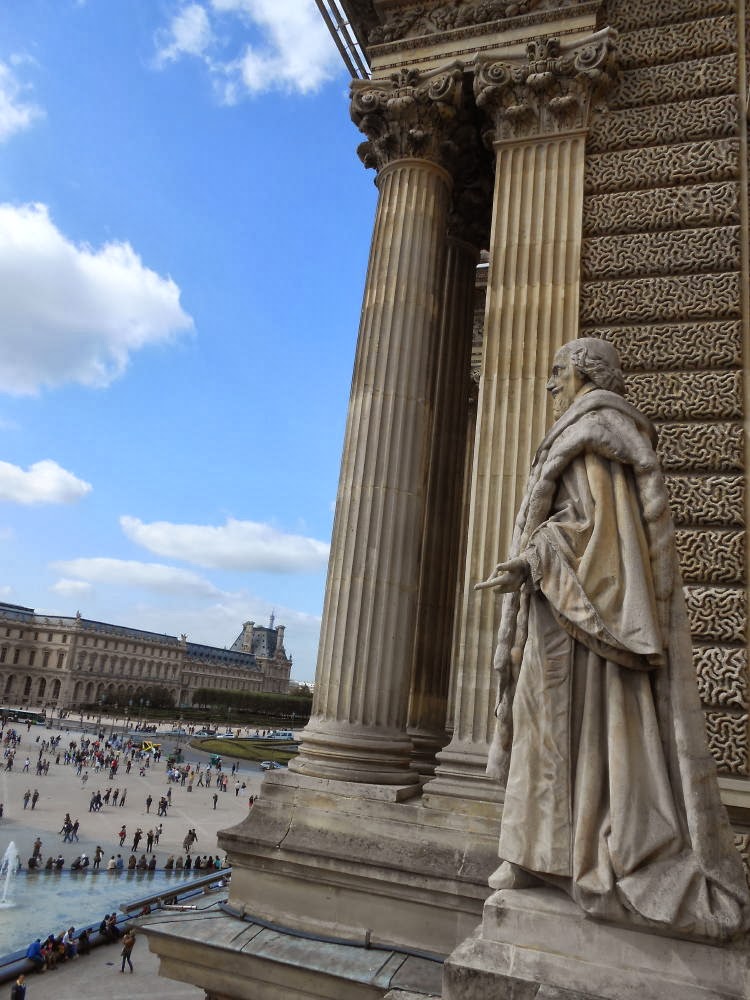We woke up early so that we could have a full day at the most famous museum in Paris - The Louvre.
 |
| The architecture of The Louvre encompasses it all! |

Rich's sister and brother-in-law had gone to Germany and France last year and absolutely loved their visit to the Louvre, so we were excited to spend most of the day here, but it's HUGE -where to start? To really understand what it is, you have to know a little bit of the history of this amazing edifice.
During the 43-yr. reign of Philippe Auguste (1180–1223), the power and influence of the French monarchy grew considerably, both inside and outside the kingdom. In 1190, a rampart was built around Paris, which was Europe’s biggest city at the time.
 |
| Philippe Auguste's fortress of 1190 |

To protect the capital from the Anglo-Norman threat, the king decided to reinforce its defenses with a fortress, which came to be known as The Louvre. It was built to the west of the city, on the banks of the Seine.
The Salle Basse (Lower Hall) is all that remains today of the Louvre’s medieval interior. Its original function is unknown. The vaulting, columns, and corbels that can be seen today date from 1230–40 and were added to the old masonry.
 |
| The only portion of the medieval crypt still visible. |
Under Charles V in 1358, the Louvre was enclosed within the expanding city and lost its defensive function. His architect began transforming the old fortress into a splendid royal residence. Contemporary miniatures and paintings contain marvelous images of ornately decorated rooftops. Apartments around the central court featured large, elaborately-carved windows.
 |
| The Medieval Keep was demolished. |
In the second half of the 16th century, the Louvre was an astonishing mixture of new buildings, work in progress, and half-ruined structures over 200 years old. The history during the Renaissance period is fascinating.
In 1791, the revolutionary Assemblée Nationale decreed that the “Louvre and the Tuileries together will be a national palace to house the king and for gathering together all the monuments of the sciences and the arts." The Museum opened with 537 paintings.
With the Revolution, the Louvre entered a phase of intensive transformation. France acquired numerous paintings and antiquities from the Vatican and the Venetian republic. These were enriched by spoils from Napoleon I's conquests. The museum was renamed the Musée Napoléon in 1803. A bust of the emperor by Bartolini was installed over the entrance. After the fall of the empire in 1815, each nation reclaimed its treasures and the museum was disbanded.
By 1874, the Louvre Palace had achieved its present form of a rectangular structure with the Sully Wing to the east containing the square Cour Carrée and the oldest parts of the Louvre; and two wings which wrap the Cour Napoléon, the Richelieu Wing to the north and the Denon Wing, which borders the Seine to the south.
 |
| The Louvre Palace and Pyramid today - so beautiful at night. |

 |
| Annibale Carraci -"The Birth of the Virgin" |

 |
| This is the biggest reason everyone comes here - for this beautiful lady. |
 |
| "Do I have the Mona Lisa smile?" |
It's amazing how small the painting really is. There was a large crowd around her, but she is only 31" x 20."
The painting by Leonardo da Vinci has been acclaimed as "the best known, the most visited, the most written about, the most sung about, the most parodied work of art in the world." The painting, thought to be a portrait of Lisa Gherardini, the wife of Francesco del Giocondo, is believed to have been painted between 1503 and 1506, although Leonardo may have continued working on it as late as 1517. It was acquired by King Francis I of France and is now on permanent display here and has been since 1797.
"Les Noches de Cana" depicts the Wedding Feast at Cana, a miracle story from the New Testament. In the story, Jesus and his disciples were invited to a wedding celebration in Cana in Galilee. Towards the end of the feast, when the wine was running out, Jesus commanded servants to fill jugs with water, which he then turned into wine (his first miracle of seven).
 |
| Wedding Feast at Cana - the largest painting at the Louvre. |
There was another large crowd around this painting which was completed in 1563 by Paolo Veronese, an Italian painter. There is quite a history about this original painting changing hands, getting damaged, and more.


 |
| "The Astronomer" by Johannes Vermeer |
Rembrandt created nearly 100 self-portraits during his lifetime including approximately 50 paintings, 32 etchings and 7 drawings. The self-portraits create a visual diary of the artist over a span of forty years.
 |
| One of Rembrandt's MANY self-portraits. |
 |
| "OUCH! - He bit my finger!" |
 |
| "The Lacemaker" - Johannes Vermeer (1600's)....one of my favorites! |
 |
| We've seen MANY amazing museums in Europe, but this has to be one of THE BEST! |

















No comments:
Post a Comment